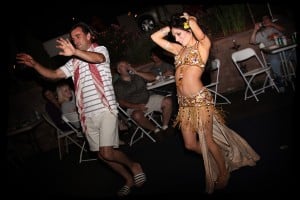
I absolutely can’t believe what a positive response my last post “Blue Eyed Soul” received over on my personal Facebook page. It’s good to know that you’re not alone, especially when you’ve bared a little piece of your soul on your “commercial” blog! But even after getting all this off my chest, I still have a lot to say. (Seriously, guys – you don’t want to spend a day inside my head!)
Looking back on some of my earlier classroom experiences, as well as several things I’ve learned throughout my professional career, I think it might be interesting to explore a few key items that, in my not so humble opinion, go into the ongoing process of becoming The Real Deal.
- There are “the rules”….and Then There are “ZOMG!!! TEH RULEZ!!!!!” I think you know where I’m going with this. Throughout your dance training, you will hear choice pieces of advice. Some “rules” are sage: “Always get a translation before you perform to a new song.” “Stay away from using Turkish music for Armenian crowds.” “Never crawl around on the floor to pick up your tips. Kindly ask somebody to do it for you.” Then, there are a host of random oddities: “Playing with your hair is indecent.” “Never show the palms of your hands.” “Don’t attempt Saidi unless you’re wearing a galabeya.” You will get a good feel for which rules make sense and which ones are urban legends. When in doubt, ask an Egyptian-born dance instructor next time you’re in a workshop.
- Expose Yourself! No, not in an “indecent” way! Expose yourself to a variety of different instructors and immerse yourself in YouTube clips of dancers from “over there,” doing their thing. This can be overwhelming, especially if the process leads to any sort of earth-shattering revelation that there were some holes in your earlier training. But you will likely find out that 1. “The Middle East” is not just a homogenous caramel-colored blob on the map, 2. individual differences exist within any given region, and 3. there’s more than one “right” way to belly dance, and there’s a lot of rule-breaking going on.
- Ask an Expert: Dancers who have been trained in the classic American Cabaret style of the 1970’s and 80’s just may be The Belly Dance Holy Grail. I’ve gleaned immeasurable insight from conversations online and in real life with Aszmara (NYC), Aradia (Las Vegas), Cory Zamora (CA), Norma (Detroit), as well as the extensive educational works of Shira. Once upon a time, before we had the luxury of buying the latest BDSS CD from Borders, belly dancers performed improv to live music. As Aszmara told us in a class one time, you could have a Greek bouzouki player, a Lebanese singer, a Turkish clarinetist and a Syrian drummer under one roof – and they liked to keep dancers on their toes! American dancers can learn invaluable lessons about versatility, musicality and showmanship from conversations with these dancers.
- Know Your Music – Bellydance Superstars CD’s are just the beginning. Revisit Egyptian classics. Download Turkish, Armenian, Greek and Lebanese compositions. Listen to them – and I mean, REALLY listen. You probably know enough steps to make up a dance, and this is useful. As for the rest? Let the music move you. Your music will tell you exactly what to do, if you listen carefully.
- Listen to Your Customers: This is a biggie. Ask tons of questions while planning your sets. Not only is this a fantastic business practice, but it’ll also give you key insight into the preferences of your clientele. Also, listen to random pieces of feedback after your show.
- Be Yourself: As an American dancer, the least I can do is train in all styles of belly dance, immerse myself in different types of music, become well-rounded, and apply my own unique spin to every performance. If I moved to Tuscany and learned to speak Italian, I would eventually become fluent enough to write, carry on conversations, and read classical Italian poetry. But I might never get rid of my accent, and I might slip into the occasional quirky idiom. Still, people will know what I am saying. In dance, I may never get rid of my “American accent,” but as long as I capture the essence and musicality my clients are looking for, and as long as I love what I am doing, others will see my “accent” as something endearing and unique.
‘Til the next chapter ;)
Carrara
